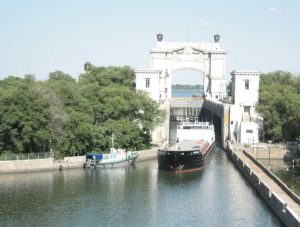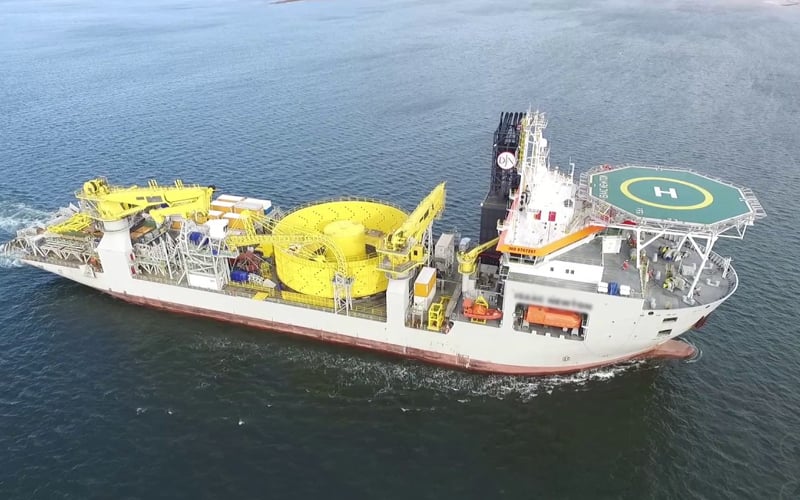By Dave Marie
 The Caspian Sea, the largest body of inland water, is bordered by five countries with a combined population exceeding 270 million, including approximately 14 million living in coastal provinces. It has long supported pipeline/energy connectivity as well as trade and cargo transportation.
The Caspian Sea, the largest body of inland water, is bordered by five countries with a combined population exceeding 270 million, including approximately 14 million living in coastal provinces. It has long supported pipeline/energy connectivity as well as trade and cargo transportation.
However, despite the fact that a resilient, high-speed reliable and secure data connectivity is an essential requirement in the modern era, there is a conspicuous absence of any submarine cables connecting any of the Caspian Sea’s bordering countries.
The below figure highlights the lack of trans-Caspian Sea connectivity. (The thin blue lines in the map represent terrestrial fibre routes, and the thin green lines represent submarine fibre routes).
Although several submarine cable projects have been considered in the Capsian Sea over the years by various industry stakeholders, it has taken many years to develop a viable solution. However, as of May 2025, AzerTelecom and Kazakhtelecom have finally overcome the challenges to building an international submarine cable in the Caspian Sea.
Why is a Submarine Cable across the Caspian Sea needed?
There are several compelling reasons why a submarine cable across the Caspian Sea would offer significant strategic and business advantages:
- Improving the connectivity for Central Asia;
- Leveraging the Caspian’s strategic geographic location;
- Establishing a diverse, high-capacity, high-speed, secure telecom corridor between Asia and Europe that bypasses areas of geopolitically unstable regions;
- Creating a resilient and reliable alternative telecommunication route; and
- Strengthening and enabling regional government digital infrastructure and data centre initiatives.
Challenges to building in the Caspian Sea
Given the clear business and social benefits for implementing a submarine cable across the Caspian Sea, as well as non-challenging technical factors such as a relatively shallow body of water and unchallenging distances, why has it taken so long for a cable project to actually begin implementation? Is the barrier political, geographical or technical?
The answer—all of the above!
This overview aims to highlight some of the key challenges that have hampered previous attempts to build a cable but will soon be overcome as the Trans-Caspian Cable project moves from concept to reality—unlocking significant benefits to the entire region.
Political
In the 2018 Convention on the Legal Status of the Caspian Sea, the five bordering countries reached an agreement and signed a treaty on the division of the body of water by the presidents of Russia, Azerbaijan, Iran and Turkmenistan in Aktau, Kazakhstan. This landmark decision established that each country had its own defined maritime boundaries with no ‘international waters’ within the Caspian Sea. Prior to this Convention, there was no formal Agreement on how the Caspian Sea was to be classified (i.e., a sea or a lake), which enabled the larger states, (i.e., Russia and Iran), to obstruct international infrastructure projects. However, the outcome of the 2018 Convention Agreement addressed this by ruling that the Caspian Sea is neither a sea nor a lake but is considered a ‘special body of water’ (hybrid of the two). Most importantly, each country was granted sovereignty over its designated zones and removed the requirement for unanimous approval from all of the coastal states.
However, other geopolitical concerns still remain, such as sanctioned countries or areas considered security risks which continue to complicate the development of such infrastructure projects.
Environmental and Geology
The Caspian Sea presents a relatively unknown and variable marine environment, with shifting soft sediments, mud, and silt areas, in addition to other rocky areas. Due to the absence of any existing submarine cables crossing the Caspian Sea, there is no precedent or comprehensive data that provides guidance on any specific installation methodologies. Detailed bathymetric survey information is also lacking, and this limited level of information presents significant challenges for accurate planning and engineering.
Additionally, marine operations in the Caspian Sea are seasonally dependent. Strong winds (leading to rough waters and big waves), icy conditions, and low visibility in the winter months would severely limit marine activities. As a result, marine cable operational work needs to be limited to the late spring to early autumn period in order to mitigate the very unfavorable winter months.
Permitting
With the absence of any existing submarine telecom cables crossing the Caspian Sea, and only regional oil and gas infrastructure to provide a reference, there are limited precedents to support the permitting requirements. Furthermore, there is no legal framework currently in place for submarine cables crossing the Caspian Sea. As a result, both the process and duration of obtaining necessary permits remain largely undefined. Given that permitting is typically a critical path activity during the early phases of the project, this uncertainty adds to the complexities of project planning and risk management in the region.
Logistics
One of the biggest challenges in deploying a trans-Caspian submarine system is how would more than 500 tons of submarine cable be transported to a body of water that is landlocked?
 Typically, submarine cables are transported from the manufacturing plant to the installation site via freighter or specialised cable ship. However, the only practical waterway route accessing the Caspian Seais the Volga-Don Canal, connecting the Black and Caspian seas, which includes multiple relatively narrow locks (as shown below), and only supports shallow draft vessels, all of which significantly limit allowable vessel size and cargo loads. Furthermore, geopolitical risks, such as sanctions and limited insurance availability, restrict the international use of this waterway. As a result, the Volga-Don Canal is widely considered neither a viable nor a reliable option for the delivery of submarine cables using out-of-region cable ships.
Typically, submarine cables are transported from the manufacturing plant to the installation site via freighter or specialised cable ship. However, the only practical waterway route accessing the Caspian Seais the Volga-Don Canal, connecting the Black and Caspian seas, which includes multiple relatively narrow locks (as shown below), and only supports shallow draft vessels, all of which significantly limit allowable vessel size and cargo loads. Furthermore, geopolitical risks, such as sanctions and limited insurance availability, restrict the international use of this waterway. As a result, the Volga-Don Canal is widely considered neither a viable nor a reliable option for the delivery of submarine cables using out-of-region cable ships.
Although an option to transport submarine cable using standard shipping containers via sea, road, or rail is possible, this would result in cable loads being delivered in very short spans (approximately 30km per container), leading to multiple joints and added increased optical losses.
 Road transportation may also be a consideration for longer cable lengths, but it would require heavily customised, bespoke vehicles and suitable supporting infrastructure. The image below shows that it is possible to transport very heavy loads overland, provided suitable conditions, infrastructure, and equipment are available.
Road transportation may also be a consideration for longer cable lengths, but it would require heavily customised, bespoke vehicles and suitable supporting infrastructure. The image below shows that it is possible to transport very heavy loads overland, provided suitable conditions, infrastructure, and equipment are available.
To avoid this issue, consideration could also be given to in-region cable manufacturers; however, this would require considerable time, cost, and external expertise to modify and bring a factory up to submarine cable quality standards, which may not justify a valid business case if it’s only for one or two systems.
Vessel Availability
Another key challenge arising from the absence of previous submarine cable installations in the Caspian Sea, is the lack of suitably equipped and capable cable installation vessels and equipment in the region.
As previously noted, the only practical access to the Caspian Sea is the Volga-Don Canal, which cannot support the access or transit of suitably equipped and well-established cable laying vessels, therefore isolating the Caspian Sea from using the global fleet of purpose-built submarine cable ships.
Another factor for consideration is that there may be a regulatory requirement for marine vessels that operate in the Caspian Sea to be locally flagged.
Considering these constraints, the most likely solution would then be to re-purpose one of the many available offshore support vessels that are already operating in the region, and to then modify and make it suitable for cable laying operations. Below is an example of a support vessel converted for cable laying.

Conclusion
In summary, the significant logistical, technical, and regulatory challenges presented by the Caspian Sea have undoubtedly been limiting factors to why there are no submarine cables installed to date. Nevertheless, with effective solutions, strong determination, good project management, and the involvement of the right key stakeholders, these challenges will undoubtedly be overcome.
For comments or questions, please contact us via [email protected].
Image Credits (in order shown):
- https://geographical.co.uk/geopolitics/geopolitics/item/2776-claiming-the-caspian, CC BY-SA 4.0 <https://creativecommons.org/licenses/by-sa/4.0>, via Wikimedia Commons.
- Source: ITU/BDT Broadband maps (www.itu.int/go/maps).
- By Дмитрий Николенко – Own work, Public Domain, https://commons.wikimedia.org/w/index.php?curid=1200053.
- J Brew, CC BY-SA 2.0 <https://creativecommons.org/licenses/by-sa/2.0>, via Wikimedia Commons
- Free Malaysia Today; https://images.app.goo.gl/EkcPVamzy35EkRa56

